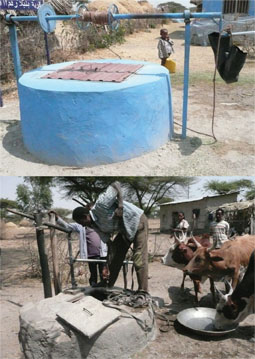Protection of well water from pollution and contamination
Before and during water source development, care should be taken to minimise possible risks. The well should be located on a higher level than possible sources of contaminants such as latrines and cesspits (a pit for collection of waste matter and water especially sewage). This is because the liquid from the pit may seep into the surrounding ground and into the groundwater. If the latrine is higher up a slope than the well then the contaminated groundwater is likely to flow downwards and into the well. The natural flow of the groundwater (the hydraulic gradient) should be away from the well and towards the sources of contaminants, and not the other way round. In normal soils, the minimum distance between the well and the source of contaminants should never be less than 15 metres and a distance of 30–50 m is recommended. However for limestone and some other soil formations this distance needs to be greater because groundwater can pass very easily through some rocks and soils.
The inside wall of the well should be made waterproof by constructing a well casing. As noted above, in small diameter bored wells the casing can be a pipe, but in larger wells the casing needs to be constructed by cementing from the top of the well down to a minimum depth of 3 metres. The casing of the well should also be extended for a minimum of 60 cm above the surrounding ground level to prevent the entrance of surface runoff. A concrete cover should be fitted over the casing to prevent dust, insects, small animals and any other contaminants from falling in.

A pump should be installed, but if a pump is not available then a sanitary bucket and rope system may be used. The immediate area of the well should preferably be fenced to keep animals away. The area surrounding the well should be graded off (i.e. should slope away from the well) in order to prevent the flow of storm water into the well.